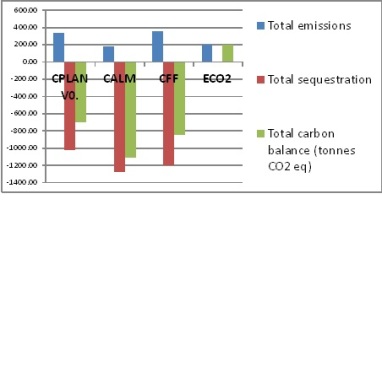The latest EBLEX beef and sheep roadmap was published yesterday. EBLEX, the organisation set up by the government to promote English beef and lamb, finally admitted that they had been ignoring a huge factor in the overall carbon footprint of livestock – namely the carbon stored in grassland soils. But they claimed that the science was not good enough yet to be able to factor in the way grassland management impacts on that carbon.
This huge (around 2 gigatonnes of carbon is stored in grassland soils) factor has also been ignored in the nationally recognised carbon footprint calculator called PAS2050, though there are now moves afoot to remedy this omission.
Bill Grayson, upland farmer and Grazing Animals Project pioneer, calculated his stock’s carbon footprint using 4 different calculators.
Fig 2. Comparative assessment of one farm’s total C-budget (t CO2-eq) using four different calculators: C-Plan, CALM, Carbon Friendly Food and E-CO2 (unpublished data courtesy Soil Association)
As you can see, the variation is huge, from a net footprint of 200 tonnes CO2-equivalent, to a net sequestration of 1100 tonnes C02-equivalent. EBLEX is using E-Co2 to calculate the carbon footprint of English livestock, which gives the biggest carbon footprint for extensive systems such as the ones Bill’s animals graze.
I asked Bill what he thought of the latest EBLEX proposals – this is what he said
“I approve of EBLEX’s recognition of sequestration as a key issue but I’m disappointed that they are not more positive about the prospects for including it in their C assessment methodology. C-assessments being used by the EC are already incorporating preliminary soil-sequestration values. This is based on exactly the same cautious but realistic rationale as the many other provisional estimates already used elsewhere in the international C-reporting process. Many of the more extensive livestock producers in England will be unfairly disadvantaged, relative to their European counterparts if this aspect of their C-performance continues to be omitted from the calculation. In my own case I have found that the results from the CALM calculator which include the C-sequestration associated with LULUCF as per IPCC reporting guidelines, shows that my beef system locked up 1100 t CO2 eq in 2010. The ECO2 model used in the Roadmap, by contrast, suggested that my system emitted nearly 200t CO2 eq in that same year. As a farmer concerned about these important issues I need to know that all the relevant aspects of my C-performance are going to be included in the assessment process. Only then can I be sure that any changes I make to my management practices will not risk throwing the baby out with the bathwater.”
Until this problem is resolved, EBLEX and the Government will continue to argue, wrongly, that intensive livestock management is more carbon-friendly than extensive systems.

